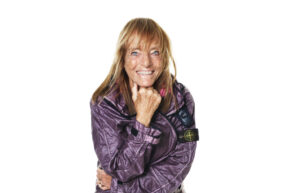
In the cultural imagination, skateboarding has long been synonymous with concrete jungles, sun-bleached Californian ramps, and the echo of wheels against warehouse walls. But what happens when that same rebellious energy takes root not in Venice Beach, but in the misty hills and sleepy towns of Northwest England? And what if, instead of the usual parade of beanies and baggy pants, the skaters carving the bowls are women, non-binary, and gender-diverse riders, rewriting a story they were once excluded from?
This is the world of “Skate Like a Lass,” the latest project from visual artist Juliet Klottrup, a zine-turned-film-turned-exhibition that chronicles a thriving yet under-documented FLINTA+ (female, lesbian, intersex, non-binary, trans, agender, and more) skate scene.
Set not in a sprawling metropolis but in Blackpool, Preston, and the Lake District, Klottrup’s work captures a subculture emerging from unlikely places—and in doing so, shows us that skating isn’t just urban rebellion anymore. It’s rural resistance. It’s redefinition. It’s reclamation.
Origins on the Rooftop
The genesis of the project began, fittingly, on top of a multi-story car park. Klottrup was invited to a DIY “skate jam” hosted by Cumbria Cvven, a local collective with a tagline that sparked the project’s name: “Skate Like a Lass.”
Due to a lack of funding, the collective couldn’t rent an indoor skate spot, so they did what skaters have always done—they adapted. “People had built ramps out of scrap wood, there was music, snacks, people of all ages and abilities,” Klottrup recalls. “It was buzzing.”
She knew then this was a story that needed to be told—not just in photos, but in collaboration, through community-led zines, short films, and exhibitions. The result is a vibrant, defiant snapshot of identity, place, and resistance told through the lens of grip tape and concrete.
Beyond the City: Why the Northwest?
Rather than focusing on skate scenes in cities with pre-built skateparks and public support, Klottrup zeroed in on the “non-city centric” communities of the northwest. Why? Because these are the spaces where building anything—especially a safe, inclusive collective—takes more effort, more love, more guts.
“I’m from a big family with three brothers who skated. I devoured skate zines and VHS tapes as a teenager. I played Tony Hawk, always as Elissa Steamer,” says Klottrup. “But the older I got, the less I saw of women in the scene.”
That invisibility is what “Skate Like a Lass” challenges head-on. Not by yelling over history, but by quietly archiving the present, making sure these new voices—and wheels—are recorded.
Zines, Research, and Radical Aesthetics
Klottrup’s process wasn’t just documentary; it was archival, co-creational, and historically engaged. Working alongside designer Femke Campbell, she researched 1980s Californian zines, vintage skateboards from the 1960s, and even typography from old skate brand ephemera to design her own zine.
“We found a board in a museum with this hand-painted type, and we lifted that exact style for the zine,” she says. “It was about locating ourselves within the history of skating, while pushing it forward with new voices.”
And that’s the tension at the heart of the project—heritage meets redefinition. A sport that’s historically been tied to hyper-masculinity and rebellion is being lovingly cracked open by FLINTA+ communities who bring their own energy to the space.
Collectives as Cultural Resistance
Two key collectives featured in the project are Empress Skateboarding (Preston) and Slag Collective (Blackpool). Each emerged not just as a space to skate, but as counter-narratives to traditional skate culture, where gatekeeping, gender policing, and intimidation were too often the norm.
The name “Slag Collective” comes from a moment of reclamation. After being called “skatepark slags,” the group decided to own the insult, flipping it into a name that would draw strength from marginalization.
And the collectives aren’t just about skating. They’re about space. About safety. “For some people, just being there is the win,” Klottrup says. “You don’t have to master a trick. Maybe you just talk to someone. Maybe you just watch. That’s what matters.”
Freedom, Failure, and Starting Again
What resonated most with Klottrup during her two-year journey weren’t just the stories of ollies and half-pipes. It was the emotional space skating offered.
“When I asked people what skating felt like,” she says, “the most common word was freedom.”
That’s not surprising. In a world where FLINTA+ people still face surveillance, skepticism, and safety risks, the ability to take up space freely—to fall, get up, and fall again—is a small revolution.
Skating teaches failure. And failure, in the hands of community, becomes resilience.
A Mother and Daughter, Learning Side by Side
One of the most powerful vignettes from the zine features a mother-daughter duo learning to skate together. It’s an image that shatters every stereotype about who skate culture is for—and what it can mean.
“To see a woman and her daughter both learning, both falling, both laughing—it was beautiful,” Klottrup says. “That intergenerational connection, in a neutral space that isn’t work or school, is rare. And it’s deeply necessary.”
Documenting What History Forgot
There’s a sense, throughout “Skate Like a Lass,” that Klottrup is doing the work history forgot. Not just celebrating women and non-binary skaters, but documenting their rise in real-time—before they’re edited out of the narrative.
She doesn’t pretend to “fix” the erasure of the past. Instead, she stakes out space in the present. “I can’t rewrite history,” she says, “but I can archive the now.”
Final Thoughts: Skateboarding as Soft Resistance
In a time when skateboarding has officially gone Olympic, sponsored, and sanitized, “Skate Like a Lass” reminds us that the most radical spaces are still the grassroots, imperfect, DIY collectives where freedom looks like a hand-me-down board and a cold parking garage.
Klottrup’s work isn’t nostalgic. It’s hopeful. It doesn’t romanticize the struggle—it shows us what happens when people make space for each other, despite it.
This is skateboarding as soft resistance. As sanctuary. As shared joy on four wheels.
“Skate Like a Lass” is more than a project—it’s a movement on the move. You just have to look past the skateparks and into the car parks to find it.
No comments yet.








